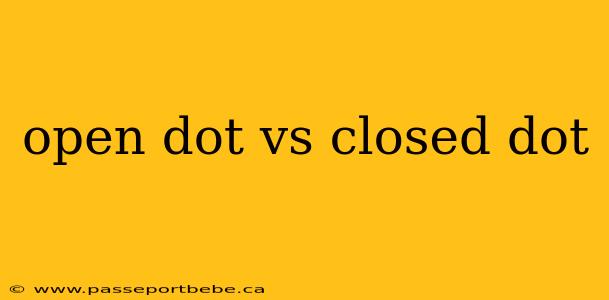Open Dot vs Closed Dot: A Deep Dive into the Art of Music Notation
For those familiar with musical notation, you've likely encountered the enigmatic dot. But what exactly does this tiny mark signify? And how does its presence or absence impact the sound of a musical piece? Let's unravel the mysteries of the open dot and the closed dot, exploring their individual roles and revealing the hidden world of rhythm they inhabit.
Open Dot: The Subtle Lengthener
The open dot, also known as a dotted note, appears right after a note head, signifying a lengthening of the note's duration. It's like adding an extra slice of time to a musical note, making it slightly longer than its regular counterpart.
Here's how it works:
- A dotted note is 50% longer than its original value. For example, a dotted quarter note is equivalent to a quarter note plus an eighth note (1.5 beats).
- Dots can be chained! A double dot adds another 25% to the note's duration (1.75 beats for a double-dotted quarter note), and a triple dot adds another 12.5% (1.875 beats).
Let's illustrate this with a practical example:
Imagine a simple melody consisting of a series of quarter notes. Each note is a beat long. Now, imagine adding a dot to one of those quarter notes. That single dot transforms the beat into a 1.5-beat long note, significantly altering the flow and feel of the melody.
Think of it like this: Imagine a metronome. An open dot tells the metronome to tick an extra half-beat!
Example from Stack Overflow:
"How do you calculate the length of a dotted note?" - User: music-lover
Answer: A dotted note is equal to 1.5 times the value of the original note. For example, a dotted quarter note is equal to 1.5 quarter notes. - User: TheRhythmGuru
Closed Dot: The Note That Never Was
In contrast to its open counterpart, the closed dot, often referred to as a fermata, signifies a pause or hold. It's a small, filled-in circle placed above or below the note head.
Here's how it works:
- It indicates a pause lasting longer than the note's original value. The exact duration is usually left to the performer's discretion, but it's generally a pause of significant length.
- It's commonly used to highlight the note's importance or emotional impact.
Think of it like this: The closed dot tells the musician to hold the note and let it linger, creating a moment of dramatic pause in the musical narrative.
Example from Stack Overflow:
"What is the difference between a dot and a fermata in musical notation?" - User: music-newbie
Answer: A dot extends the note's duration by 50%, while a fermata indicates a pause of unspecified length. - User: TheMusicTeacher
Conclusion: A Symphony of Dots
The open dot and the closed dot, though seemingly simple symbols, hold a significant power in musical notation. They dictate the ebb and flow of rhythm, shaping the emotional landscape of a composition. By understanding their roles, we can gain a deeper appreciation for the nuances of musical expression. So, the next time you encounter a dot in a piece of sheet music, take a moment to consider its meaning – it may just unlock a whole new world of musical understanding.
